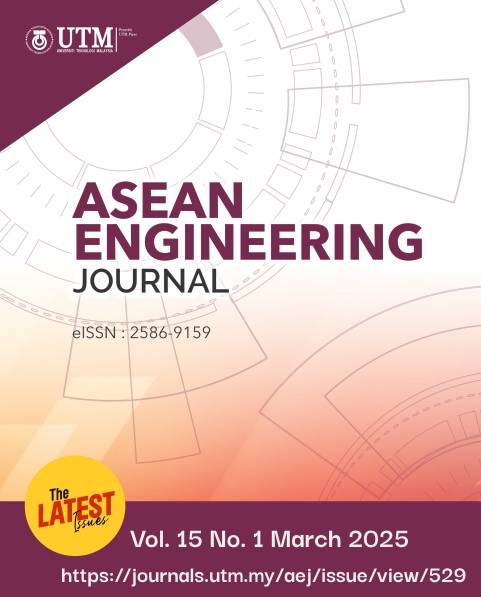DEVELOPMENT OF AUTOMATED SEALING SYSTEM FOR AIRCRAFT COMPONENTS
DOI:
https://doi.org/10.11113/aej.v15.21299Keywords:
automated sealing system, dispensing system, nozzle applicator, aircraft components, rib panelAbstract
Automating assembly lines in aircraft manufacturing poses significant challenges, entailing both technological complexities and financial risks. A key technical hurdle lies in the precise application of sealant to the aircraft rib panel wing's edge surfaces, which proves to be one of the most intricate operations in the automated manufacturing process due to the complex spatial shapes involved. In this context, the adoption of human-robot collaboration emerges as a viable approach to achieve the necessary customization and adaptability in automation. The fundamental idea is to enhance process efficiency and elevate product quality by employing a sensitive robot to support workers in the manufacturing process. The study has primarily focused on incorporating three distinct mechanisms - a dispensing mechanism, a nozzle applicator, and a robotic arm with a workstation - as essential components of the hardware. These mechanisms play a pivotal role in the successful implementation of the automated robotic sealing system. During the development phase, the system underwent rigorous testing to establish the critical parameters required for the automated robotic sealing process. Results from the study show the ideal pressure range for the dispensing system lies between 2.0 and 3.5 bar. For the nozzle applicator system, the most efficient approach involves extending the base of the 4 mm short straight roller and incorporating a makeup puff. The findings have demonstrated the method and parameters used to achieve optimal results for aircraft components using the automated sealing system process.
References
K. Zhou, G. Ebenhofer, C. Eitzinger, U. Zimmermann, C. Walter, J. Saenz, L. P. Castano, M. A. Hernandez, and J. N. Oriol, 2014 “Mobile manipulator is coming to aerospace manufacturing industry,” 2014 IEEE International Symposium on Robotic and Sensors Environments (ROSE) Proceedings,
Editorial Team, Ed., 2020. “Automated adhesive dispensing systems - types & applications,” #HowToRobot. [Online]. Available: https://howtorobot.com/expert-insight/automated-adhesive-dispensing-systems- types-applications. [Accessed: 14-Dec-2022].
M. Tyrrell, 2020 “Automated sealing of aircraft components reaches industrial maturity,” Aerospace Manufacturing. [Online]. Available: https://www.aero- mag.com/broetje-automation-sealing-aircraft-components-04062020. [Accessed: 14-Dec-2022]
Mark Fairchild Freelance Technical Copywriter and F. T. Copywriter, 2022. “How robots help aerospace manufacturers,” #HowToRobot, [Online]. Available: https://howtorobot.com/expert-insight/aerospace-robots. [Accessed: 14-Dec-2022].
3M, 2018. “Scotch-weld epoxy adhesive,” Scotch-Weld™ Epoxy Adhesive 2216 B/A, Oct- [Online]. Available: https://multimedia.3m.com/mws/media/153955O/3mtm-scotch-weldtm-epoxy-adhesive-2216-b-a.pdf?&X5x&_EVuQEcuZgVs6EVs6E666666--. [Accessed: 13-Dec-2022].
The Foam Company, 2021 “Polystyrene: Polyethylene: Polyurethane foams,” The Foam Company [Online]. Available: https://www.thefoamcompany.com.au/. [Accessed: 08-Dec-2022].
R. Mueller, A. Geenen, and M. Vette, 2015. “Potentials of human-robot-cooperation in Aircraft Assembly Systems / new possible applications of a human-robot-cooperation in aircraft production by the example of Shell Structure Assembly,” SAE Technical Paper Series,
R. Müller, M. Vette-Steinkamp, and A. Geenen, 2018. “Sealing Process on a Large Floor Grid Crossbeam Assembly through Human-Robot Cooperation,” ISR 2018,
DIY-Robotics, 2022. “What you should know about cartesian robots: Blog,” DIY Robotics, 02-Jun- [Online]. Available: https://diy-robotics.com/blog/what-you-should- know-about-cartesian-robot/. [Accessed: 08-Dec-2022].
HowToRobot, 2019. “Articles,” #HowToRobot. [Online]. Available: https://howtorobot.com/robot-insights. [Accessed: 14-Dec-2022].
X. Gong, X. Cao, D. Li, Y. Xu, Q. Xie, Q. Wu, and J. Wang, 2021. “Accurate and reliable sealant inspection for aircraft fuel tank based on 3-D Point Cloud,” IEEE Transactions on Instrumentation and Measurement, 70: 1–16.
U. Robots, 2020. “Cobots in dispensing - collaborative robots,” Universal Robots, https://www.universal-robots.com/applications/dispensing/ [Accessed: 08-Dec-2022].
E. Adhesives, 2020. “Ellsworthadhesives.eu,” FISNAR Catalog-Engineered Dispensing Solutions, [Online]. Available: https://ellsworthadhesives.eu/wp- content/uploads/2020/05/Fisnar-Catalog-Engineered-Dispensing-Solutions.pdf. [Accessed: 08-Dec-2022].
Chiptronics (M) Sdn. Bhd. 2019. “TS7000,” Chiptronics (M) Sdn. Bhd., [Online]. Available: http://www.chiptronics.com.my/product/ts7000/. [Accessed: 08-Dec-2022].
The Gale Group Inc, 2006. “Foam rubber,” How Products Are Made. [Online]. Available: http://www.madehow.com/Volume-5/Foam-Rubber.html. [Accessed: 08-Dec- 2022].
E. Freund and D. Rokossa, 1998. “Automatic trajectory generation for multi-joint robot system,” IECON ’98. Proceedings of the 24th Annual Conference of the IEEE Industrial Electronics Society (Cat. No.98CH36200).
Z. L. Xu and G. Fang, 2002. “Fuzzy impedance control for robots in complex spatial edge following,” 7th International Conference on Control, Automation, Robotics and Vision, 2002. ICARCV 2002.
L. Chih-Jer and L. Ming-Yen, 2018. “Motion Planning With Obstacle Avoidance of An UR3 Robot Using Charge System Research,” 18th International Conference on Control, Automation and System (ICCAS 2018),
Hypercoat, 2017. “Product EC-2216 B/A Epoxy Adhesive Gray,” Hypercoat. [Online]. Available: https://www.hypercoat.com.sg/product/ec-2216-b-a-epoxy-adhesive-gray/. [Accessed: 18-Jan-2023].
















